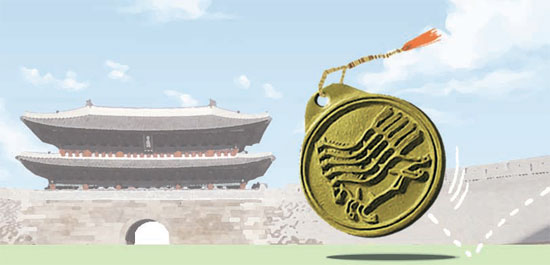Audit board too slow on the uptake

But it always turns up too late. The special investigation into the Sewol accident, which began on May 14, is no exception. Fifty elite officials are looking into the Ministry of Security and Public Administration, the Ministry of Oceans and Fisheries, the Coast Guard, the Korean Register of Shipping and the Korea Shipping Association to review accident management, rescue operations and vessel safety check procedures. They are determined to propose a plan that will prevent further disasters.
Not surprisingly, the probe is overdue. The Korean Register of Shipping was entrusted the job of checking the safety of vessels, but the audit board hasn’t conducted an inspection on the register itself for 10 years. According to the Busan District Prosecutors’ Office, a team chief at the Korean Register of Shipping frequently gave gift certificates to officials at the Oceans Ministry and treated them to drinks and golf.
If the audit board had openly warned the Ministry of Oceans and Fisheries that 11 of the 14 agencies under the ministry, including the Korean Register of Shipping and the Korea Shipping Association, were being headed by retired ministry officials, the extensive cartel could have been halted. Whether the audit board was aware of neglected maritime safety or not, it wouldn’t have been able to avoid criticism that its inspections on the ministry were for appearance’s sake.
On May 15, the audit board announced its report on the Sungnyemun restoration. The process of overhauling the monument was flawed, it said. An unverified painting technique and chemical adhesives were used. The Cultural Heritage Administration officials in charge of the project cared more about convenience and meeting the deadline than doing the job properly. They changed the original plan at their discretion, ruining National Treasure No. 1. The audit board ordered five officials to be reprimand, but citizens are not convinced that these irresponsible people are truly being punished. The board acted too late.
The audit board’s symbol is Mapae, the “horse requisition tablet” carried by secret royal inspectors during the Joseon Dynasty (1392-1910). In one story, Lee Mong-ryong took out the tablet and revealed his identity in order to save Chunhyang, who was being beaten for refusing to serve Byeon Hak-do. Presenting the tablet was all about timing.
*The author is a political news reporter of the JoongAng Ilbo.
JoongAng Ilbo, May 16, Page 29
By HEO JIN










with the Korea JoongAng Daily
To write comments, please log in to one of the accounts.
Standards Board Policy (0/250자)